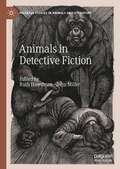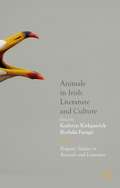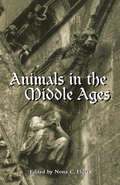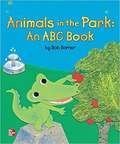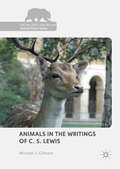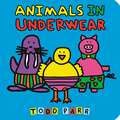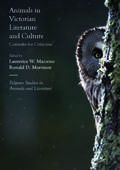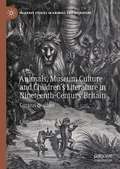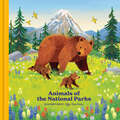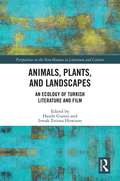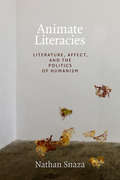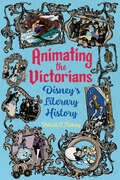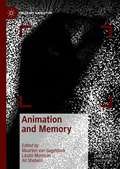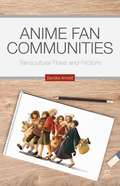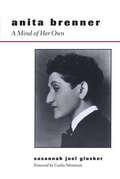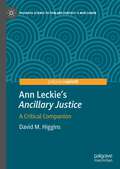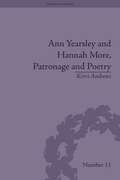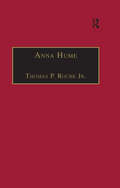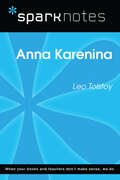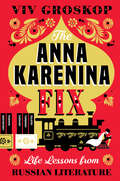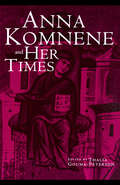- Table View
- List View
Animals Everywhere [Grade 1, Unit 4] (Elementary Core Reading Ser.)
by Donald Bear McGraw-Hill EducationNIMAC-sourced textbook
Animals in Detective Fiction (Palgrave Studies in Animals and Literature)
by Ruth Hawthorn John MillerThis book explores the vast array of animals that populate detective fiction. If the genre begins, as is widely supposed, with Edgar Allan Poe’s “Murders in the Rue Morgue” (1841), then detective fiction’s very first culprit is an animal. Animals, moreover, consistently appear as victims, clues, and companions, while the abstract conception of animality is closely tied to the idea of criminality. Although it is often described as an essentially conservative form, detective fiction can unsettle the binary of human and animal to intersect with developing concerns in animal studies: animal agency, the ethical complexities of human/animal interaction, the politics and literary aesthetics of violence, and animal metaphor. Gathering its 14 essays into sections on ontologies, ethics, politics, and forms, Animals in Detective Fiction provides a compelling and nuanced analysis of the central role creatures play in this enduringly popular and continually morphing literary form.
Animals in Irish Literature and Culture
by Kathryn Kirkpatrick Borbála FaragóAnimals in Irish Literature and Culture spans the early modern period to the present, and includes essays exploring some of Ireland's better known animals—birds, horses, pigs, cows, and dogs—as well as its less considered animals—hares, foxes, eels, and insects. The collection also unsettles the boundaries and definitions of 'nation' by exploring colonial, post-colonial, and globalized manifestations of Ireland as country and state as well as the human animal and non-humananimal migrations that challenge a variety of literal and cultural borders. In essays addressing a range of Irish cultural production, contributors consider the impacts of conceptual categories of nature, animality, and humanness on actual human and animal lives. Emerging in the era of the sixth mass extinction, brought on by human-induced climate change and habitat destruction, this volume aims to make a contribution to eco-critical thought and practice in Irish Studies and beyond.
Animals in the Middle Ages: A Book Of Essays (Routledge Medieval Casebooks #Vol. 13)
by Nona C. FloresThese interdisciplinary essays focus on animals as symbols, ideas, or images in medieval art and literature.
Animals in the Park: An ABC Book [Big Book] (Elementary Core Reading Ser.)
by Bob BarnerNIMAC-sourced textbook <P><P>See what animals like to do in the park at night
Animals in the Writings of C. S. Lewis (The Palgrave Macmillan Animal Ethics Series)
by Michael J. GilmourThis book examines C. S. Lewis's writings about animals, and the theological bases of his opposition to vivisection and other cruelties. It argues Genesis is central to many of these ethical musings and the book's organization reflects this. It treats in turn Lewis's creative approaches to the Garden of Eden, humanity's "dominion" over the earth, and the loss of paradise with all the catastrophic consequences for animals it presaged. The book closes looking at Lewis's vision of a more inclusive community. Though he left no comprehensive summary of his ideas, the Narnia adventures and science fiction trilogy, scattered poems and his popular theology inspire affection and sympathy for the nonhuman. This study challenges scholars to reassess Lewis as not only a literary critic and children's author but also an animal theologian of consequence, though there is much here for all fans of Mr. Bultitude and Reepicheep to explore.
Animals in Underwear ABC
by Todd ParrFrom alligator to zebra - with a goldfish, iguana, yak, and even a unicorn in between - there's no better way to learn the alphabet than with animals... in underwear! Todd Parr's signature kid-friendly illustrations and bold colors showcase an array of animals in all kinds of hilarious underwear styles, making learning the alphabet tons of fun. Featuring a padded cover and gate folds on every spread, here's a playful, silly way for kids to learn their ABCs!
Animals in Victorian Literature and Culture: Contexts for Criticism (Palgrave Studies in Animals and Literature)
by Laurence W. Mazzeno Ronald D. MorrisonThis collection includes twelve provocative essays from a diverse group of international scholars, who utilize a range of interdisciplinary approaches to analyze "real" and "representational" animals that stand out as culturally significant to Victorian literature and culture. Essays focus on a wide range of canonical and non-canonical Victorian writers, including Charles Dickens, Anthony Trollope, Anna Sewell, Emily Bronte, James Thomson, Christina Rossetti, and Richard Marsh, and they focus on a diverse array of forms: fiction, poetry, journalism, and letters. These essays consider a wide range of cultural attitudes and literary treatments of animals in the Victorian Age, including the development of the animal protection movement, the importation of animals from the expanding Empire, the acclimatization of British animals in other countries, and the problems associated with increasing pet ownership. The collection also includes an Introduction co-written by the editors and Suggestions for Further Study, and will prove of interest to scholars and students across the multiple disciplines which comprise Animal Studies.
Animals, Museum Culture and Children’s Literature in Nineteenth-Century Britain: Curious Beasties (Palgrave Studies in Animals and Literature)
by Laurence TalairachAnimals, Museum Culture and Children’s Literature in Nineteenth-Century Britain: Curious Beasties explores the relationship between the zoological and palaeontological specimens brought back from around the world in the long nineteenth century—be they alive, stuffed or fossilised—and the development of children’s literature at this time. Children’s literature emerged as dizzying numbers of new species flooded into Britain with scientific expeditions, from giraffes and hippopotami to kangaroos, wombats, platypuses or sloths. As the book argues, late Georgian, Victorian and Edwardian children’s writers took part in the urge for mass education and presented the world and its curious creatures to children, often borrowing from their museum culture and its objects to map out that world. This original exploration illuminates how children’s literature dealt with the new ordering of the world, offering a unique viewpoint on the construction of science in the long nineteenth century.
Animals of the National Parks: An Alphabet Book
by Fifty-Nine ParksFor nature lovers of any age, this book is a beautiful A-to-Z introduction to the wild and wonderful animals that live in America's national parks. Featuring art from the beloved printmakers and poster illustrators at Fifty-Nine Parks.America's national parks are some of the most magical places in the world, and home to a diverse array of creatures, both well known and more unusual. From American Bison (which are also the largest mammals in the parks) to flying squirrels (which can glide the length of a football field) to Xeme (which take two full years to grow their adult feathers), this picture book takes children on an enchanting alphabetical adventure through the natural world.The book features fascinating facts about each animal, including information on where they can be found. A passport page to record visits and an illustrated map of all the national parks will encourage children and their families to make the most of every trip. With beautifully evocative art that's nostalgic yet contemporary, this is a special gift for outdoor and national park lovers of all ages.
Animals, Plants, and Landscapes: An Ecology of Turkish Literature and Film (Perspectives on the Non-Human in Literature and Culture)
by Hande Gurses Irmak Ertuna HowisonThe landscape of Turkey, with its trees and animals inspires narratives of survival, struggle and escape. Animals, Plants, and Landscapes: An Ecology of Turkish Literature and Film, will be the first major study to offer fresh theoretical insight into this landscape, by offering a collection of analyses of key texts of Turkish literature and cinema. Through discussion of both classical and contemporary works, this volume, paves the way for the formation of a ecocritical canon in Turkish literature and the rise of certain themes that are unique to Turkish experience. Snakes, fishermen and fish who catch men, porcupines contemplating on human agency, dogs exiled on an island and men who put dogs to fights, goat herders and windy steppes of Anatolia are all agents in a territory that constantly shifts. The essays included in this volume demonstrate the ways in which the crystallized relations between human and non-human form, break, and transform.
Animals Small and Huge (Reach Into Phonics Ser.)
by Deanne W. Kells Kelsey Bruce Deborah J. ShortNIMAC-sourced textbook
Animate Literacies: Literature, Affect, and the Politics of Humanism (Thought in the Act)
by Nathan SnazaIn Animate Literacies Nathan Snaza proposes a new theory of literature and literacy in which he outlines how literacy is both constitutive of the social and used as a means to define the human. Weaving new materialism with feminist, queer, and decolonial thought, Snaza theorizes literacy as a contact zone in which humans, nonhuman animals, and nonvital objects such as chairs and paper all become active participants. In readings of classic literature by Kate Chopin, Frederick Douglass, James Joyce, Toni Morrison, Mary Shelley, and others, Snaza emphasizes the key roles that affect and sensory experiences play in literacy. Snaza upends common conceptions of literacy and its relation to print media, showing instead how such understandings reinforce dehumanizations linked to dominant imperialist, heterosexist, and capitalist definitions of the human. The path toward disrupting such exclusionary, humanist frameworks, Snaza contends, lies in formulating alternative practices of literacy and literary study that escape disciplined knowledge production.
Animating the Victorians: Disney's Literary History (Children's Literature Association Series)
by Patrick C. FlemingMany Disney films adapt works from the Victorian period, which is often called the Golden Age of children’s literature. Animating the Victorians: Disney’s Literary History explores Disney’s adaptations of Victorian texts like Alice in Wonderland, Oliver Twist, Treasure Island, Peter Pan, and the tales of Hans Christian Andersen. Author Patrick C. Fleming traces those adaptations from initial concept to theatrical release and beyond to the sequels, consumer products, and theme park attractions that make up a Disney franchise. During the production process, which often extended over decades, Disney’s writers engaged not just with the texts themselves but with the contexts in which they were written, their authors’ biographies, and intervening adaptations. To reveal that process, Fleming draws on preproduction reports, press releases, and unfinished drafts, including materials in the Walt Disney Company Archives, some of which have not yet been discussed in print. But the relationship between Disney and the Victorians goes beyond adaptations. Walt Disney himself had a similar career to the Victorian author-entrepreneur Charles Dickens. Linking the Disney Princess franchise to Victorian ideologies shows how gender and sexuality are constantly being renegotiated. Disney’s animated musicals, theme parks, copyright practices, and even marketing campaigns depend on cultural assumptions, legal frameworks, and media technologies that emerged in nineteenth-century England. Moreover, Disney’s adaptations influence modern students and scholars of the Victorian period. By applying scholarship in Victorian studies to a global company, Fleming shows how institutions mediate our understanding of the past and demonstrates the continued relevance of literary studies in a corporate media age.
Animation and Memory (Palgrave Animation)
by László Munteán Maarten Van Gageldonk Ali ShobeiriThis book examines the role of memory in animation, as well as the ways in which the medium of animation can function as a technology of remembering and forgetting. By doing so, it establishes a platform for the cross-fertilization between the burgeoning fields of animation studies and memory studies. By analyzing a wide range of different animation types, from stop motion to computer animation, and from cell animated cartoons to painted animation, this book explores the ways in which animation can function as a representational medium. The five parts of the book discuss the interrelation of animation and memory through the lens of materiality, corporeality, animation techniques, the city, and animated documentaries. These discussions raise a number of questions: how do animation films bring forth personal and collective pasts? What is the role of found footage, objects, and sound in the material and affective dimensions of animation? How does animation serve political ends? The essays in this volume offer answers to these questions through a wide variety of case studies and contexts. The book will appeal to both a broad academic and a more general readership with an interest in animation studies, memory studies, cultural studies, comparative visual arts, and media studies.
Anime Fan Communities
by Sandra AnnettHow have animation fans in Japan, South Korea, the United States, and Canada formed communities and dealt with conflicts across cultural and geographic distance? This book traces animation fandom from its roots in early cinema audiences, through mid-century children's cartoon fan clubs, to today's digitally-networked transcultural fan cultures.
Anita and Me
by Meera SyalThis is the story of Meena the nine-year-old, daughter of the only Punjabi family in the mining village of Tollington. A vision of British childhood in the 1960s, caught between two cultures, each on the edge of enormous change is portrayed here.
Anita Brenner: A Mind of Her Own
by Susannah Joel GluskerJournalist, historian, anthropologist, art critic, and creative writer, Anita Brenner was one of Mexico's most discerning interpreters. In this book, her daughter, Susannah Glusker, traces Brenner's intellectual growth and achievements from the 1920s through the 1940s. This intellectual biography brings to light a complex, fascinating woman who bridged many worlds--the United States and Mexico, art and politics, professional work and family life. Journalist, historian, anthropologist, art critic, and creative writer, Anita Brenner was one of Mexico's most discerning interpreters. Born to a Jewish immigrant family in Mexico a few years before the Revolution of 1910, she matured into an independent liberal who defended Mexico, workers, and all those who were treated unfairly, whatever their origin or nationality. In this book, her daughter, Susannah Glusker, traces Brenner's intellectual growth and achievements from the 1920s through the 1940s. Drawing on Brenner's unpublished journals and autobiographical novel, as well as on her published writing, Glusker describes the origin and impact of Brenner's three major books, Idols Behind Altars, Your Mexican Holiday, and The Wind That Swept Mexico. Along the way, Glusker traces Brenner's support of many liberal causes, including her championship of Mexico as a haven for Jewish immigrants in the early 1920s. This intellectual biography brings to light a complex, fascinating woman who bridged many worlds--the United States and Mexico, art and politics, professional work and family life.
Ann Leckie’s "Ancillary Justice": A Critical Companion (Palgrave Science Fiction and Fantasy: A New Canon)
by David M. HigginsThis book argues that Ann Leckie’s novel Ancillary Justice offers a devastating rebuke to the political, social, cultural, and economic injustices of American imperialism in the post 9/11 era. Following an introductory overview, the study offers four chapters that examine key themes central to the novel: gender, imperial economics, race, and revolutionary agency. Ancillary Justice’s exploration of these four themes, and the way it reveals how these issues are all fundamentally entangled with the problem of contemporary imperial power, warrants its status as a canonical work of science fiction for the twenty-first century. The book concludes with a brief interview with Leckie herself touching on each of the topics examined during the preceding chapters.
Ann Radcliffe, Romanticism and the Gothic
by Dale Townshend Angela WrightThis book offers unique and fresh perspectives upon the literary productions of one of the most highly remunerated and widely admired authors of the Romantic period, Ann Radcliffe (1764 1823). While drawing upon, consolidating and enriching the critical impulses reflected in Radcliffe scholarship to date, this collection of essays, composed by a range of renowned scholars of the Romantic period, also foregrounds the hitherto neglected aspects of the author's work. Radcliffe's relations to Romantic-era travel writing; the complex political ideologies that lie behind her historiographic endeavours; her poetry and its relation to institutionalised forms of Romanticism; and her literary connections to eighteenth-century women's writing are all examined in this collection. Offering fresh considerations of the well-known Gothic fictions and extending the appreciation of Radcliffe in new critical directions, the collection reappraises Radcliffe's full oeuvre within the wider literary and political contexts of her time.
Ann Yearsley and Hannah More, Patronage and Poetry: The Story of a Literary Relationship (Gender and Genre #11)
by Kerri AndrewsThis study offers a timely and necessary reassessment of the careers of Ann Yearsley and Hannah More. Making use of newly-discovered letters and poems, Andrews provides a full analysis of the breakdown of the two writers’ affiliation and compares it to other labouring-class relationships based on patronage.
Anna Hume: Printed Writings 1641–1700: Series II, Part Three, Volume 8 (The Early Modern Englishwoman: A Facsimile Library of Essential Works & Printed Writings, 1641-1700: Series II, Part Three)
by Thomas P. Jr.Little is known of Anna Hume except as the translator of the first three of Petrach's Trionfi and also as the daughter of David Hume of Godscroft whose History of the Houses of Douglas and Angus she edited in one of its troubled versions. This volume reprints her translation of Petrarch's The Triumphs of Love - a series of six poems celebrating Petrarch's purported devotion to Laura. The poems tell a tale of Love's triumph over the poet, superseded by the triumph of chastity (in that Laura did not yield to Petrarch's love) which is in turn superseded by the triumph of death over Laura. Hume's 1644 translation is reproduced here with five related texts as appendices - an emblem and poem by Robert Farley; the translation of The Triumph of Eternitie by Elizabeth I; the translation of The Triumph of Death by Mary Sidney Herbert; illustrations from Il Petrarcha con l'espositione di M. Alessandro Vellutello...and the translation of lines 102-172 of The Triumph of Death by Barbarina Ogle Brand, Lady Dacre.
Anna Karenina (SparkNotes Literature Guide Series)
by SparkNotesAnna Karenina (SparkNotes Literature Guide) by Leo Tolstoy Making the reading experience fun! Created by Harvard students for students everywhere, SparkNotes is a new breed of study guide: smarter, better, faster. Geared to what today's students need to know, SparkNotes provides: chapter-by-chapter analysis explanations of key themes, motifs, and symbols a review quiz and essay topics Lively and accessible, these guides are perfect for late-night studying and writing papers.
The Anna Karenina Fix: Life Lessons from Russian Literature
by Viv Groskop“In this hilarious, candid, and thought-provoking memoir, [Groskop] explains how she used lessons from Russian classics to understand herself better.” —Gretchen Rubin, #1 New York Times–bestselling authorAs Viv Groskop knows from personal experience, everything that has ever happened to a person has already happened in the Russian classics: from not being sure what to do with your life (Anna Karenina), to being hopelessly in love with someone who doesn’t love you back (Turgenev’s A Month in the Country), or being socially anxious about your appearance (all of Chekhov’s work). In The Anna Karenina Fix, a sort of literary self-help memoir, Groskop mines these and other works, as well as the lives of their celebrated creators, and her own experiences as a student of Russian, to answer the question “How should you live your life?” This is a charming and fiercely intelligent book, a love letter to Russian literature and an exploration of the answers these writers found to life’s questions.“[Groskop is] a delight, a reader’s reader whose professional and personal experiences have allowed her to write the kind of book that not only is complete unto itself, but makes you want to head to the library and revisit or discover the great works she loves.” —The Washington Post“Learn how to hack life nineteenth-century Russian style! You’ll totally be like Anna Karenina without getting (spoiler alert) run over by a train!” —Gary Shteyngart, New York Times-bestselling author“For anyone intimidated by Russia’s daunting literary heritage, this humorous yet thoughtful introduction will serve as the perfect entrée.” —Publishers Weekly
Anna Komnene and Her Times (Garland Medieval Casebooks #Vol. 29)
by Thalia Gouma-PetersonThis significant critical anthology explores the life of Anna Komnene, the Byzantine context in which she wrote, and the impact of the Alexiad on her times and on subsequent historical works of literature.

